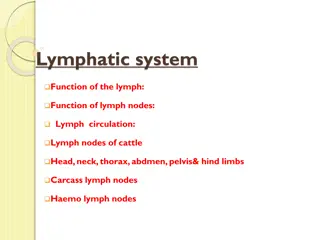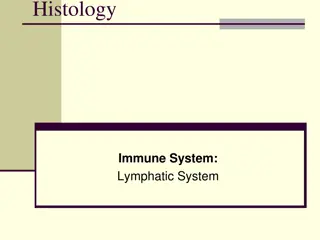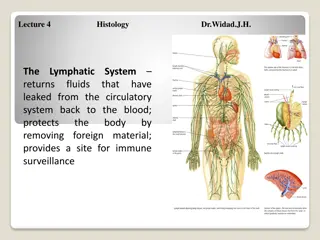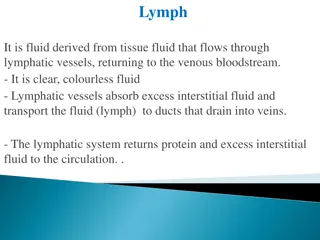
Understanding the Lymphatic System and Its Functions
Explore the vital role of the lymphatic system in maintaining homeostasis, immune defense, and fluid balance. Learn about its structure, functions, and lymph circulation to enhance your understanding of this crucial bodily system.
Download Presentation

Please find below an Image/Link to download the presentation.
The content on the website is provided AS IS for your information and personal use only. It may not be sold, licensed, or shared on other websites without obtaining consent from the author. If you encounter any issues during the download, it is possible that the publisher has removed the file from their server.
You are allowed to download the files provided on this website for personal or commercial use, subject to the condition that they are used lawfully. All files are the property of their respective owners.
The content on the website is provided AS IS for your information and personal use only. It may not be sold, licensed, or shared on other websites without obtaining consent from the author.
E N D
Presentation Transcript
INTRODUCTION TO THE LYMPHATIC SYSTEM MR S.T GASHIRAI
Introduction Lymphatic system contributes to homeostasis by draining interstitial fluid as well as providing a mechanism for defence against disease. Immunity is the body s ability to ward off damage or disease through defence mechanisms. Two types of immunity are Innate (Non specific) Immunity an Adaptive (specific) Immunity.
Functions of lymphatic system Drains excess interstitial fluid - Lymphatic vessels drain excess interstitial fluid from tissue spaces and return it to the blood. (e.g plasma protiens) Transports dietary lipids - Lymphatic vessels transport lipids and lipid-soluble vitamins (A, D, E, and K) absorbed by the gastrointestinal tract. Carries out immune responses - Lymphatic tissue initiates highly specific responses directed against particular microbes or abnormal cells.
Lymphatic system Structure and Function Consists of fluid called lymph, lymphatic vessels, organs and structures containing lymphatic tissue and red bone marrow. Most blood plasma components filter through capillary walls to form interstitial fluid. When interstitial fluid passes into lymph vessels, it becomes lymphatic fluid. Major difference between the two is location.
Structure and function Lymphatic tissue is a specialised form of reticular connective tissue which contains large numbers of lymphocytes. Remember lymphocytes are agranular leukocytes Two types of lymphocytes participate in adaptive immunity B and T lymphocytes.
Lymphatic vessels and lymph circulation Lymphatic vessels begin as blind-ended lymph capillaries in tissue spaces between cells Interstitial fluid drains into lymphatic capillaries, thus forming lymph. Overlapping endothelial cells (lymphatic capillary wall) allow for one way flow. Lymph capillaries merge to form larger vessels, called lymphatic vessels, which convey lymph into and out of structures called lymph nodes.
Lymphatic vessels and lymph circulation
Lymphatic vessels and lymph circulation Lymphatic capillaries are found throughout the body except in avascular tissue, the CNS, portions of the spleen, and red bone marrow. Lymphatic capillaries have a slightly larger diameter than blood capillaries and have overlapping endothelial cells that work as one-way valves for fluid to enter the lymphatic capillary. Anchoring filaments attach endothelial cells to surrounding tissue cells. A lymphatic capillary in the villus of the small intestine is the lacteal. It functions to transport digested fats form the small intestine into blood.
Formation and flow of lymph More fluid filters out of blood capillaries than returns to them via reabsorption. Excess drained fluid about 3lt/day drains into lymphatic vessels and becomes lymphatic fluid. Interstitial fluid drains into lymph capillaries Capillaries then empty into vessels which eventually lead to lymph nodes. Vessels from lymph nodes unite to form trunks.
Formation and flow of lymph Principal trunks are; lumbar,- drain lower limbs, pelvis, kidneys, adrenal glands and abdominal wall intestinal, - stomach, intestines, spleen and part of liver bronchomediastinal, - chest wall, lungs and heart subclavian upper limbs jugular trunks head and neck
Formation and flow of lymph Lymph passes from trunks into two main channels the thoracic duct and the right lymphatic duct. Thoracic (left lymphatic) duct is about 38 45 cm long. Begins as a dilation called the cisterna chyli anterior to L2. Drains lymph into venous blood at the junction of the left internal jugular and left subclavian veins. Receives lymph from the left side of the head, neck, and chest, the left upper limb, and the entire body inferior to the ribs
Formation and flow of lymph The right lymphatic duct is about 1.2 cm long Receives lymph from the upper right side of the body Drains into venous blood at the junction of the right internal jugular and right subclavian veins.
Flow of lymph Lymph flows as a result of the "milking action" of skeletal muscle contractions and respiratory movements. It is also aided by lymphatic vessel valves that prevent backflow of lymph. The same two pumps that return venous blood to heart, maintain flow of lymph. Skeletal pump and respiratory pump.
Lymphatic organs and tissues Primary lymphatic organs are the red bone marrow and the thymus gland that produce B and T cells. This is the site where stem cells divide and become immunocompetent. Secondary lymphatic organs are encapsulated structures: the lymph nodes and spleen Most immune responses occur in secondary lymphatic organs. Tertiary lymphatic organs are lymphatic nodules, which are clusters of lymphocytes that stand guard in all mucous membranes; also, the appendix, tonsils and adenoids.
Presentations lymphatic organs Discuss the anatomy and function of the following: Group 1 thymus Group 2 lymphnode Group 3 spleen Group 4 lymphatic nodules






















